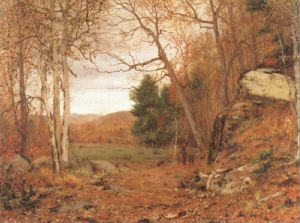American painter Edward Hopper was born on this day in 1882. The spare, cool, detached way he depicts his subjects contrasts powerfully with his use of dramatic darkness, intense light and shadow and vivid colors. Hopper’s works are carefully composed to create interest and visual movement even though the subjects themselves are usually completely still.
Hopper painted many architecturally interesting exteriors, landscapes and interior scenes, and even his compositions involving human figures emphasize an architectural sense of balance, order and solidity. The compositions and settings are as much the subject of his paintings as the people portrayed in them are.
Most of Hopper’s masterwork, “Nighthawks,” was painted just after the attack on Pearl Harbor, when the U.S. was plunged into fear that there would be air attacks on the U.S. mainland. Americans began sewing blackout curtains for their windows as the people of Britain had been doing for years in efforts to make it harder for potential attackers to target their homes from the air. But while the country prepared for enemy attacks, Hopper continued to work into the evenings with his studio curtains wide open. Appropriately, “Nighthawks” featured four people awake late at night in an empty landscape, together yet somehow separated from each other in a bright but foreboding cafe.
In nature, nighthawks are nocturnal predators of the nightjar family. They, like the nighthawks of the painting, spend the night awake—restless, watching, waiting.
The contrast between still, calm, composed subjects and vibrant color surrounded by intense darkness makes his works visually exciting, but also inspires feelings of melancholy and alienation. Hopper has inspired many other visual artists, including filmmakers like Sam Mendes, Ridley Scott and the Coen Brothers. Mendes’s bleak and brilliant film “The Road to Perdition” in particular reads as a perfect visual homage to the painter, with each scene composed, colored and lit like a Hopper painting.

